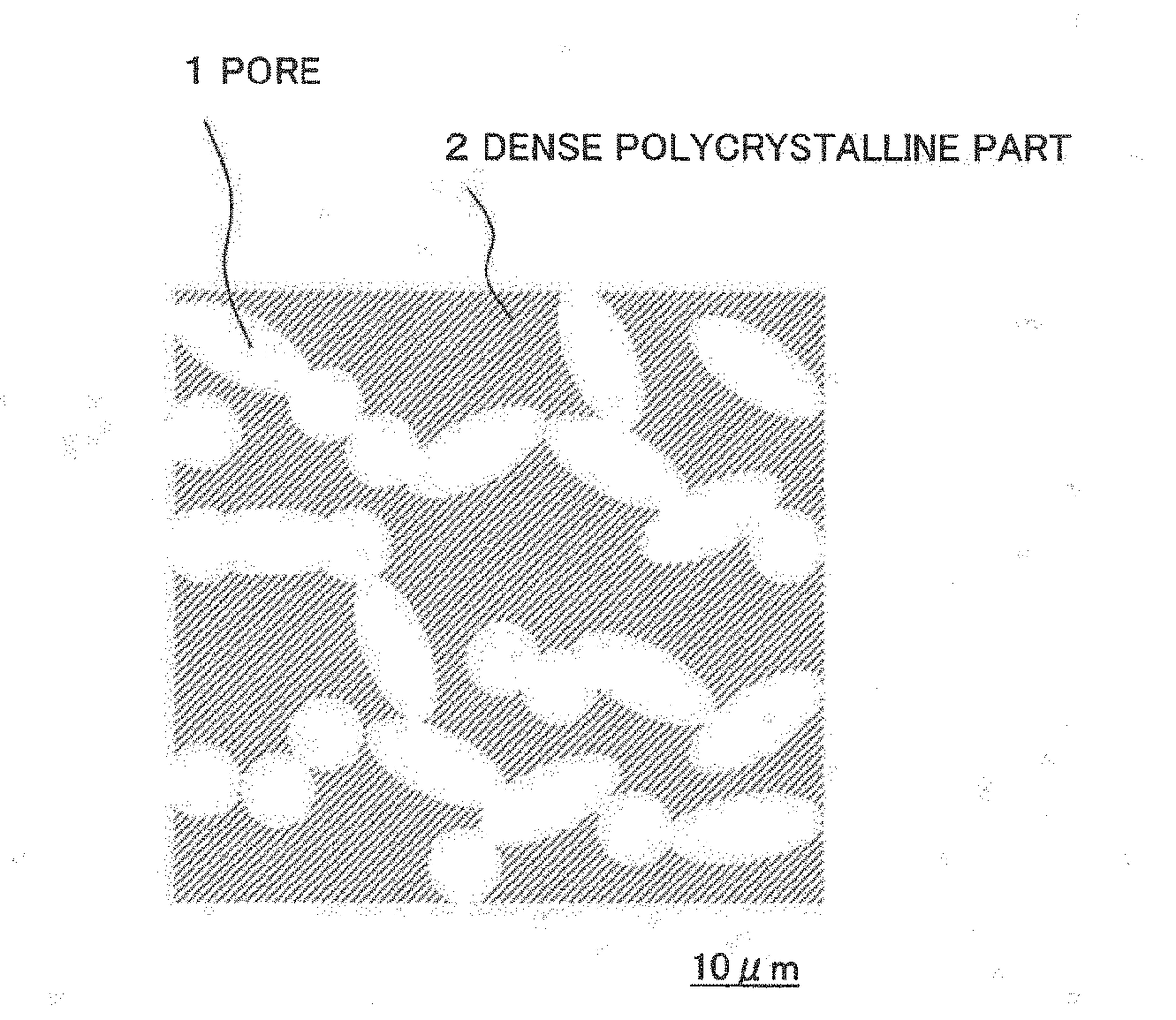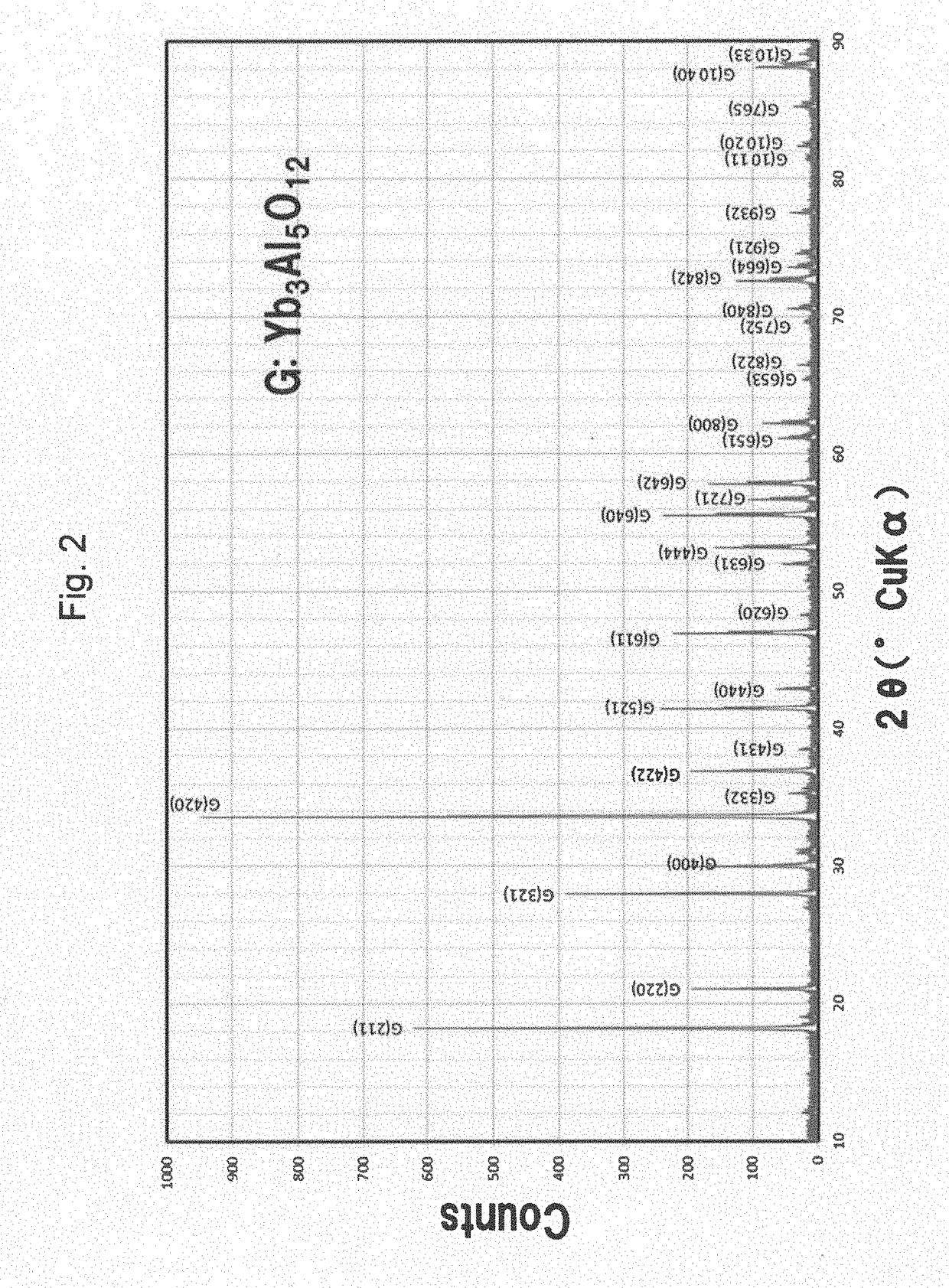Ceramic emitter
a ceramic emitter and emitter technology, applied in ceramicware, pv power plants, other domestic objects, etc., can solve the problems of metal emitter, inability to increase efficiency, degraded by oxidization or recrystallization, etc., and achieve excellent wavelength selectivity and high radiation intensity.
- Summary
- Abstract
- Description
- Claims
- Application Information
AI Technical Summary
Benefits of technology
Problems solved by technology
Method used
Image
Examples
example 1
[0040]As materials of a ceramic emitter, Yb2O3 and Al2O3 powders are used and weighed at a stoichiometric mixture ratio such that the mixture becomes Yb3Al5O12 after synthesizing. Subsequently, the mixture is added with ethanol and wet-mixed in an agate mortar, then calcined for two hours at 1600° C. in the atmosphere, thereby obtaining a garnet crystal of the above-described compositional formula by solid-state reaction. Thereafter, the garnet crystal is grounded in an agate mortar, pressed into a pellet, and fired at 1600° C. for 12 hours, thereby obtaining a polycrystalline sintered body of a disc shape. The pellet size after sintering is 12.8 mm in diameter and 1.1 mm in thickness. The porosity of this sintered body is confirmed as 36% by a density measurement using the Archimedes method. Further, to prevent water from infiltrating the pores, the density measurement is performed after coating the surface of the sintered body with a cellulose resin.
[0041]FIG. 2 illustrates a powd...
example 2
[0043]As materials of a ceramic emitter, Yb2O3 and Ga2O3 powders are used and mixed in the same way as Example 1, calcined at 1600° C. for 2 hours in the atmosphere, pressed into a pellet, and then fired at 1500° C. for 2 hours to obtain a Yb3Ga5O12 sintered body.
[0044]It is confirmed by powder X-ray diffraction that the sintered body obtained in the same way as Example 1 has a single phase garnet structure. Further, the size of the sintered body is 12.7 mm in diameter and 0.9 mm in thickness. The porosity is 32% by the density measurement.
[0045]The thermal radiation spectra of the sintered body are measured at 957° C. and 1017° C. in the same way as Example 1 and the results are illustrated in FIG. 7. In the same way as Example 1, selective radiation can be confirmed at a wavelength of approximately 1000 nm that matches with the sensitivity wavelength of the Si photovoltaic cell, while radiation of a wavelength of 1200 nm or more is suppressed. It is observed that the wavelength se...
example 3
[0046]As materials of a ceramic emitter, Er2O3 and Ga2O3 powders are used and mixed in the same way as Example 1, calcined at 1600° C. for 2 hours in the atmosphere, pressed into a pellet, and fired at 1500° C. for 2 hours to obtain an Er3Ga5O12 sintered body.
[0047]It is confirmed by powder X-ray diffraction that the sintered body obtained in the same way as Example 1 has a single phase garnet structure. Further, the size of the sintered body is 12.7 mm in diameter and 1.0 mm in thickness. The porosity is 25% by the density measurement.
[0048]The result of measuring a thermal radiation spectrum of the sintered body at 1058° C. in the same way as Example 1 is illustrated in FIG. 8, together with the measurement result of SiC at the same temperature. Selective radiation can be confirmed at a wavelength of approximately 1500 nm that matches with the sensitivity wavelength of a GaSb photovoltaic cell, whose band gap corresponds to the wavelength of 1700 nm. The ratio of the emissivity at...
PUM
| Property | Measurement | Unit |
|---|---|---|
| porosity | aaaaa | aaaaa |
| porosity | aaaaa | aaaaa |
| cross-section area | aaaaa | aaaaa |
Abstract
Description
Claims
Application Information
 Login to View More
Login to View More - R&D
- Intellectual Property
- Life Sciences
- Materials
- Tech Scout
- Unparalleled Data Quality
- Higher Quality Content
- 60% Fewer Hallucinations
Browse by: Latest US Patents, China's latest patents, Technical Efficacy Thesaurus, Application Domain, Technology Topic, Popular Technical Reports.
© 2025 PatSnap. All rights reserved.Legal|Privacy policy|Modern Slavery Act Transparency Statement|Sitemap|About US| Contact US: help@patsnap.com



